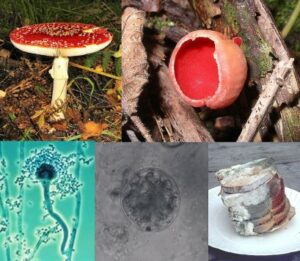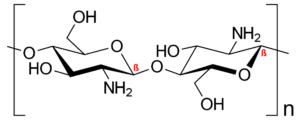Fungi are a separate classified kingdom that has a cell wall.
Fungi, like all other Kingdom Plantae species, have a cell wall that surrounds the cell membrane. Because of this before the five-kingdom classification, they were considered as a branch of kingdom Plantae.
So the answer to the question “Does fungi have a cell wall?” the answer would simply be yes they do. But later on careful investigation, it was found that they had a lot of differences from plants are hence was classified into a resolutely separate kingdom from plants. Fungi have characters that share similarities to both plants and animals.
This is because unlike plants fungi are heterotrophic or “other-eaters” by nature. This means that they solely depend on other organisms as a food source. This is different from insectivorous plants that require certain compounds absent in their natural growing medium, that they obtain from other animals.
Why do fungi have cell walls?
The cell wall in fungi is mainly a structural feature.
All organisms apart from those in the kingdom Animalia have a cell wall. Fungi were once confused as plants due to the presence of cell walls in them to give structure and shape to the cell.
Fungi appeared on the earth even before plants. So they have several similarities, but an equal number of dissimilarities. Before the Five Kingdom classification came into play, Fungi were considered a sum class of plants. But unlike plants fungi are not autotrophic organisms.
Also, they reproduce only by asexual means using spores or vegetative propagation as means. These major properties helped to distinguish Fungi into a separate kingdom of their own.

Image: Wikipedia
What is unique in the cell wall of fungi?
The uniqueness of the fungal cell wall lies in its composition.
Unlike plants, fungal cell walls are made of a heteropolysaccharide called chitin. Chitosan found in crustacean and insect exoskeletons is actually a derivative of this very chitin.
Fungal cell walls are made up of matrix components embedded in and attached to fibrous load-bearing polysaccharide scaffolds. The polysaccharide, in this case, is chitin. Chitin is a linear homopolymer of N-acetyl-d-glucosamines linked through β-(1,4)-glycosidic bonds.
This is different from plant cell walls that are composed of cellulose a linear polymer of β-1,4 linked d-glucose molecules. N-acetyl-d-glucosamine is a chemical derivative of glucose found naturally.
How do fungi have cell walls?
Fungi are primitive organisms and have a cell wall naturally.
All eukaryotic organisms apart from animals have a cell wall, so Fungi have a cell wall as well. It is merely that their cell walls have different compositions.
The plant cell wall is structural and made of cellulose. This cellulose can harden and form rigid structures like bark by accumulating lignin in themselves. On the other hand, chitin cannot produce such a structure but is strong enough to support larger structures snd also protect smalled unicellular fungi.

Chitin is a natural amino-acid sugar derivative that is found to occur naturally. Chitin in nature is more stable and strong when compared to cellulose normally as the hydroxyl group in the sugar is replaced with an acetyl amine group. This results in stronger intermolecular bonds.
Fungi cell wall characteristics:
- Specific to kingdom Fungi the cell wall lies outside of the cell membrane.
- The fungal cell wall is made of a mixture of glucans and glycoproteins instead of conventional cellulose.
- The cell wall’s function is to supply structure and support thus giving the cell stability.
- The fungal cell wall is also responsible for the cell’s ability to interact with its surroundings.
- Though chitin is the main component the fungal cell wall is a mixture of 3 main components- glucans, chitin, chitosan and glycosylated proteins.
- Several pathogen-associated molecular patterns (PAMPs) and epitopes for the immune response in a fungus are found in its cell wall.
- Toadstools are brightly coloured mushrooms found across the globe. These mushrooms are so brightly coloured to ward off their predators.
- This is because toadstools are highly poisonous and can cause severe health issues including death in some cases.
Fungi cell wall composition:
As discussed before the fungal cell wall is polymeric and arranged in various layers. It has 4 main components- chitin, chitosan, glucan and glycoproteins.
The major portion of the cell wall is made of glucans-around 50-60% in dry weight. Β-1,3-D-glucan is the most abundantly present glucan (60-95%). It is the main structural polysaccharide in the fungal cell wall.
Next comes- Chitin. The quantity of chitin in the cell wall varies depending on the species. In yeast, it constitutes only 1-2% of the total dry weight. But if we consider filamentous fungal species that proportion can reach from 10-20%. Chitin is a linear polymer composed of N-acetyl glucosamine subunits. This is a derivative of glucose produced by removing its hydroxyl group to add an acetyl amine group in its place.
The next major component are glycosylated proteins or to simply put glycoproteins. They constitute a hefty 30-50% of the dry weight in most filamentous fungal species. Glycoproteins are formed when most proteins are linked to carbohydrates via O or N links. Cell wall proteins play a variety of roles, including maintaining cellular form, adhesion activities, cellular protection against various chemicals, molecule absorption, signal transmission, and the production and rearrangement of wall components.

Image: Wikipedia
Chitosan is not considered a major factor as it is just a derivative of chitin.

Image: Wikipedia
The last and most overlooked component is melanin. This is a pigment that is present in our skin and hair and weight. Melanin is a high-molecular-weight pigment that shields fungi from stress-causing factors and allows them to persist in the host. It is negatively charged, hydrophobic, and insoluble in an aqueous solution. It is also responsible for the most commonly coloured mushrooms.
Also Read:
- What happens to a cell in a hypotonic solution
- Fuel cell aircraft
- Bacterial cell type
- Eukaryotic cells vs bacterial cells
- Are yeast multicellular
- Is cyanobacteria unicellular or multicellular
- Photocell sensors
- Is fungi multicellular or unicellular

I am Trisha Dey, a postgraduate in Bioinformatics. I pursued my graduate degree in Biochemistry. I love reading .I also have a passion for learning new languages.
Let’s connect through linked in: